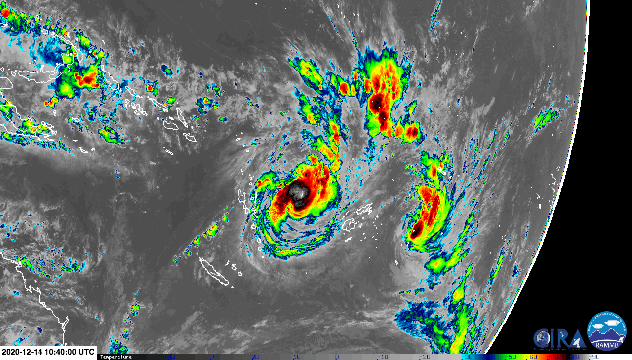Tropical Cyclones Yasa, Zazu churning in South Pacific
Following days of disorganization, the first storm of the season has finally reached tropical cyclone strength in the South Pacific and additional development was not far behind.
A tropical depression located east of Vanuatu strengthened late Sunday night, local time, to become Tropical Cyclone Yasa. At its time of formation, Yasa packed wind speeds equivalent to a tropical storm in the Atlantic and East Pacific basins.
As of Monday evening, local time, Yasa was a Category 2 Tropical Cyclone with 10-minute average sustained winds of 102 km/h (63 mph), equivalent to a strong tropical storm in the Atlantic and East Pacific basins. Yasa was drifting slowly to the west-southwest under 4 km/h (2.5 mph).
The track of this system will see Yasa slowly drift clockwise, but remain nearly stationary overall off the east coast of Vanuatu into Thursday.
Tropical Cyclone Yasa is expected to continue to bring impacts to Fiji and Vanuatu through midweek as the storm strengthens and moves slowly between the two nations. Torrential downpours, gusty winds and rough seas will impact the region into Thursday.
 |
While the heaviest downpours will likely remain offshore of Fiji, portions of Vanuatu, including Port Vila, will receive multiple rounds of heavy rain through midweek. The slow movement of the storm could mean that the threat of tropical rainfall and gusty winds may last for several days.
These bands of heavy rain can bring the risk of flash flooding and isolated wind damage. With fluctuations of the path of Yasa still possible, the stronger winds could approach closer to land should the center of the cyclone track farther to the west or east.
"A track slightly farther to the east could bring widespread heavy rainfall, flooding and mudslides across Fiji, along with an increased threat of damaging winds," AccuWeather Senior Meteorologist Adam Douty said.
This system will begin to pick up speed on Thursday and track southeast, likely narrowly avoiding landfall over Fiji.
CLICK HERE FOR THE FREE ACCUWEATHER APP
Yasa is not the only tropical concern for the South Pacific basin this week. Hot on the heels of the first tropical cyclone of the season to brew in the South Pacific, a second tropical cyclone bubbled to life in the basin early Monday morning, local time.
"Favorable conditions for tropical cyclone formation including light wind shear and warm ocean waters, are currently in place across the region," Douty explained.
An area of disturbed weather located south of American Samoa organized enough to become a tropical depression on Sunday, local time. Due to the aforementioned availability of favorable conditions, this tropical depression strengthened into Tropical Cyclone Zazu as it churned near Tonga early Monday morning, local time.
 |
Tropical Cyclone Zazu will push generally southeast over the next few days and can bring periods of heavy rain to portions of American Samoa, Tonga and Niue.
Zazu will likely drift into stronger steering-winds at the jet stream level of the atmosphere by Wednesday and will likely be quickly whisked away from any landmasses.
In addition to threats caused by wind and rain, both of these cyclones can stir up dangerous waves and lead to strong rip currents as winds around each storm become stronger. Boaters should exercise caution and avoid open waters when possible.
The area of low pressure that eventually became Yasa began developing near American Samoa earlier last week as it first strengthened into a tropical depression on Friday, while to the north of Fiji.
Before developing into a tropical cyclone, this tropical low brought heavy downpours to American Samoa from Monday to Wednesday, local time. Pago Pago International Airport recorded 62 mm (2.43 inches) during this timeframe, and higher amounts likely fell in the mountains of the island.
 |
Tropical Cyclone Yasa (left) and Tropical Cyclone Zazu (right) churn in the East Pacific Ocean basin on Monday evening, local time. (RAMMB/CIRA) |
The South Pacific tropical cyclone season officially began on Nov. 1, 2020 and will run through April 30, 2021.
Keep checking back on AccuWeather.com and stay tuned to the AccuWeather Network on DirecTV, Frontier and Verizon Fios.




